You don't know how to plant garlic - it doesn't matter: we will teach, show and tell all the secrets and subtleties
Any dish only tastes better if you add hot seasonings to it. The most famous seasoning that is easy to grow yourself is garlic.
In this article you will find answers to the most pressing questions of novice gardeners: how to plant garlic, what types of garlic exist and which type is better, when to plant garlic and when to harvest harvest... You will also learn how to deal with pests of garlic crops and what is best to plant next to this crop.
The content of the article
Types and differences of garlic
More than 70 cultivated varieties of garlic are known, each of which has its own characteristics, pros and cons, and its own ripening time. Some varieties ripen in the middle of summer, and some only in autumn. Some species require special care, while others grow in the harshest conditions.
Below you will find the most popular types and varieties of vegetables.
Type of garlic |
Garlic variety |
Description |
| Spring (spring planting, less productive).
Signs:
|
Victorio |
|
| Yelenovsky |
|
|
| Gulliver |
|
|
| Sochi 56 |
|
|
| Ershovsky |
|
|
| Winter.
Signs:
|
Lyubasha |
|
|
Dobrynya |
|
|
|
Sofievsky |
|
|
|
Alcor |
|
|
| Dubkovsky |
|
Description of varieties in video format:
Preparation and selection of the landing site
This section focuses on the correct choice of landing site and its preparation.
Soil selection
Garlic produces a good harvest in a sunny, dry area, where there will be no stagnant water.It is desirable if other crops have previously grown on this soil. It is best to plant garlic where it was previously grown tomatoes, cucumbers, legumes, cabbage, zucchini and pumpkin. Such soil will be maximally saturated with organic fertilizers.
Attention! You should not plant a crop after potatoes and onions: the risk of exchange of diseases is high (fusarium, nematode and others).
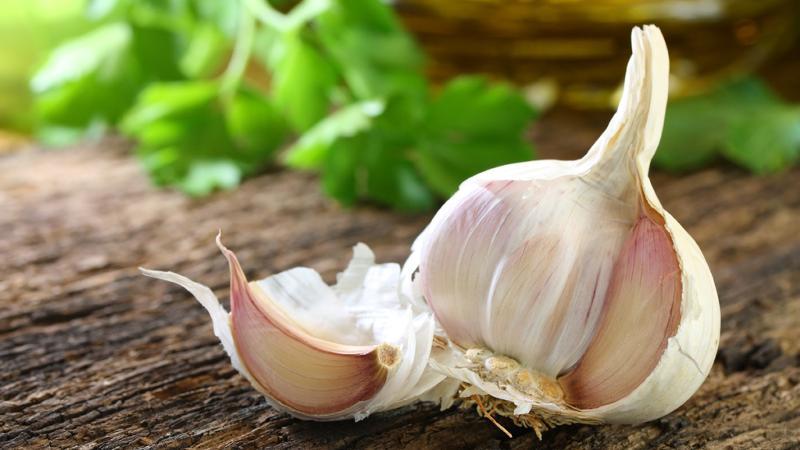
Soil preparation
When to plant spring garlic? Before planting, it is necessary to prepare the soil in advance for this type of culture. To do this, in August, they dig up the earth on a shovel bayonet and apply top dressing: a bucket of humus per square meter, 250 g of chalk, 2 glasses of wood ash and phosphorus-potassium fertilizers.
If you are making a bed, it should be about a meter wide and no higher than 25 cm high. After its formation, the earth will settle. To do this, water the soil abundantly 2-3 times.
To protect the culture from many diseases, the soil is treated with a 1% solution of copper sulfate (1 tbsp. L. Powder for one bucket of water). Pour the soil with the resulting solution and cover with foil.
Alternatives to vitriol are a strong solution of potassium permanganate, Bordeaux liquid diluted at the rate of 100 g per bucket of water, or a mixture of boric acid, potassium permanganate and copper sulphate (1 g per 1 liter of warm water).
There is another way to prepare the land, which gardeners often use. As in the first method, the earth is dug up and fertilized, the beds are watered abundantly and the soil is allowed to settle. Next, markings are made where the garlic will be planted. The spacing between the rows should not be less than 35 cm, and between the holes 10 cm.
Then the seed mixture is sown from peas, oats, mustard in the aisle. As soon as the seedlings grow to 30 cm in height, start planting the vegetable. It is planted between green rows. These plants will not only be a covering material for culture, but will also keep the snow cover, and in the spring they will become an irreplaceable soil fertilizer.
Before planting the cloves, the soil is fertilized with urea at the rate of 10-15 g per square meter. m.
Important! Prepared soil in advance in the fall is the key to a large and high-quality harvest.
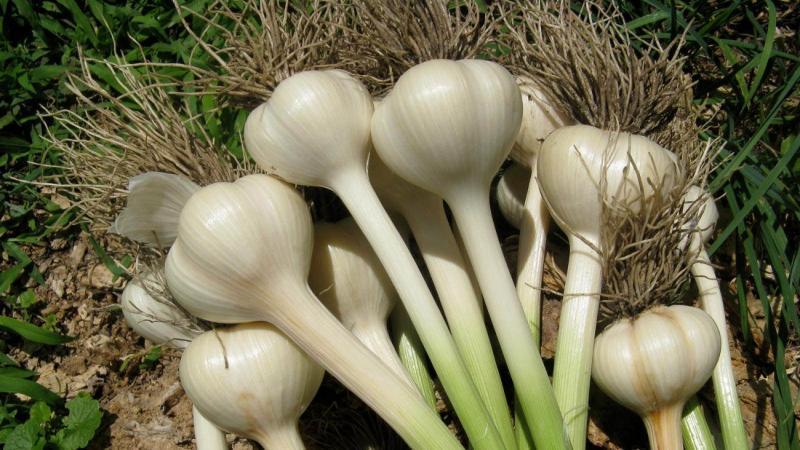
Stages of planting spring garlic
How to plant spring garlic? This type of garlic does not need a dry climate and dry soil, so spring garlic is planted in early spring when the thaw begins.
Seed treatment
For the seeds of this culture, whole, elastic, large and medium cloves weighing from 3 to 6 g or more are chosen. It is imperative that before planting they must be separated from the bulb, without removing the scales.
It is recommended to disinfect them 12 hours before planting. in a 1% solution of copper sulfate or potassium permanganate and use ash liquor. To prepare it, mix 400 g of wood ash and 2 liters of water, boil for 30 minutes, and then soak the seeds in this solution for 2 hours.
Preparation of soil and planting material
To begin with, you need to dig up the ground, loosen it, remove all weeds and pour it with a solution of salt (for one bucket of water - 3 tbsp. L.). The soil will be ready for planting in 2 days. Then you need to form furrows at a distance of 25-30 cm and a depth of 3-4 cm.
Planting spring garlic correctly as after tomato and carrots, and after cucumbers, cabbage, squash, zucchini, legumes and cereals, herbs. If onions grew here before, it is better to take a break of 2-3 years.
Planting garlic seeds
How to plant garlic correctly? When the bed is fully prepared, you need to plant the garlic seeds in the grooves down to the bottom. It is not worth pressing them in so as not to damage. Large teeth are laid out in a furrow at a distance of 10-12 cm from each other, medium ones - about 8 cm.
Having sprinkled the vegetable on top with earth, the surface of the site is slightly compacted. The garden bed is watered and covered with straw or sawdust. Some gardeners use a layer of peat, rotted compost or humus 2-3 cm thick for this.
Spring garlic sprouting
Planting and caring for garlic requires attention and patience from gardeners and gardeners.
Watering
This type of onion needs frequent watering only in the first phase of development (when greens appear). From lack of moisture, the tips of the feathers will turn yellow or dry out. In the second phase, watering should be moderate, since the vegetable is exposed to various diseases from an excess of moisture.
Top dressing
For a good harvest, the soil must have enough nutrients. For this, mineral and organic fertilizers are applied, namely:
- nitrogen fertilizers;
- 15 g of ammonium nitrate per 10 liters of water, or 1 tablespoon of urea per 10 liters of water;
- bird droppings diluted 1:12, or mullein diluted with water 1:10 (when the feather reaches a size of 6-10 cm);
- infusion of green herbs (June-July);
- 2-4 times phosphorus-potassium fertilizing with wood ash infusion (150 g per 10 l of water).
Attention: it is contraindicated to use manure as a fertilizer.
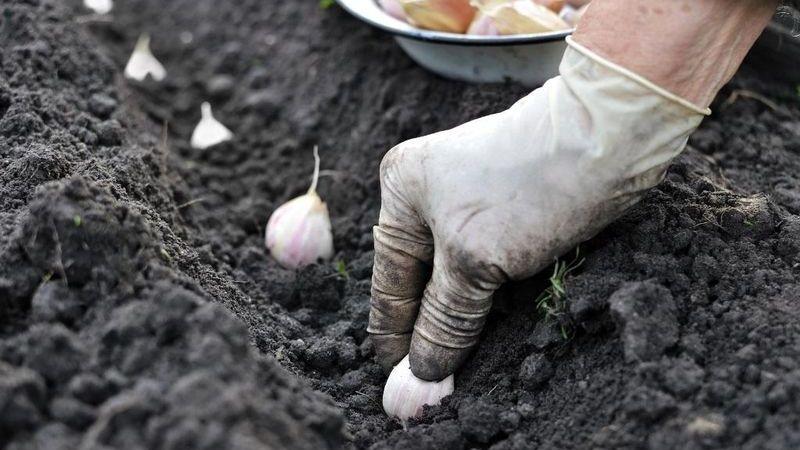
Pest and disease control
Like any plant, this type of onion must be protected from various diseases and pests, despite the fact that the culture is resistant to many factors.
Dangerous insects include:
- mole;
- thrips;
- onion flies;
- stem nematodes;
- hoverflies;
- lurkers;
- root mites.
To prevent the appearance of pests, the garlic is fed with ammonium sulfate (20 g per sq. M). The procedure should be repeated in mid-June. It is recommended to dig up plants affected by insects or disease together with the roots.
Diseases that are dangerous to garlic include:
- downy mildew;
- white rot;
- black mold;
- fusarium.
It is possible to identify a fungal disease in garlic by the following signs: yellowing and drying of leaves, feathers with yellow spots, and root death.
Brown ulcers on the bulbs, discoloration of the scales, and the smell of rot indicate bacterial lesions.
Treatment of culture "Gamair-TM" (2 tablets per 1 liter of water) and "Alirin-B" (1 tablet per 1 liter of water) will protect against fungal infections. To combat insect pests, the site is treated with biological products "Lepidocid" (50 ml per 10 liters of water) or "Bitoxibacillin" (35 ml per 5 liters of water).
What to plant between the garlic to protect the vegetable from the hookworm? Chicory or calendula are planted between its rows.

Harvesting Spring Garlic
Spring garlic is harvested in the second half of August, when most of the plant will turn yellow and light. Choose a dry day for harvesting. The vegetable is dug in with a pitchfork, taken out of the ground, cleaned from the ground and put to dry. Within 5 days, it can be dried on the ground, if time allows.
After drying, the roots of the bulbs must be shortened to 3 mm, the leaves must be trimmed, and the stems must be shortened to 10 cm. Then the crop is sorted by size and placed in storage. A dry, well-ventilated place is suitable for storing spring garlic.
For the rules of caring for spring garlic, see this video:
How to plant and grow winter garlic
How to plant winter garlic? For a winter species, the soil is chosen more fertile, loamy or sandy loam so that the acidity is neutral. Do not plant on an area that has been fertilized with manure this year, because garlic is susceptible to fungal diseases and will have loose heads.
Before planting, grooves are made on the ground, a layer of coarse sand or ash 1.5-3 cm thick is spread on the bottom. This procedure will protect the culture from decay.
Winter garlic is planted in rows at a distance of 20-25 cm, and a distance of 8 to 15 cm is left between the rows, depending on the size of the clove. How deep should you plant the garlic? The seeds are recommended to be buried in the soil by an amount of 15 to 20 cm.
Winter Garlic Care Basics
Below is a list of steps to take to care for winter garlic:
- Mulching the garden. Increases plant resistance to frost. Mulch with a mixture of sawdust and earth (or peat) is laid in a layer of 1.5-2 cm.
- Before covering the ground with snow, cover the bed with roofing material or a film covering.
- Regular watering. Water the garlic weekly (one bucket of water per square meter).
- Top dressing with a variety of fertilizers.
- Loosening the soil to a depth of 3-4 cm, and then mulching with wet peat or humus.
When to plant winter garlic
The planting time of the winter species depends on the climatic zone and weather conditions. It is better to plant garlic when 2-3 weeks remain before frost for the plant to take root. The optimum soil temperature is + 10-12 degrees.
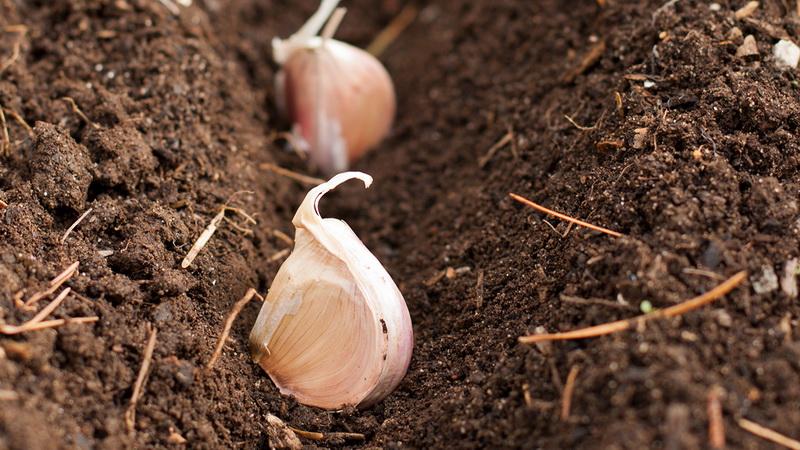
When to dig up winter garlic
The crop is ready for harvest around the end of July.
Ripeness signs:
- the bulb is covered with dry thin scales;
- leaves are softened and yellowish;
- softening of the neck begins at the place where the false stem fits.
After harvesting, the heads of the bulbous plants should be separated and put to dry, and the leaves and stems should be thrown into the compost pit.
Alternative cultivation methods
Here are some alternative ways to grow a plant.
Growing garlic on a windowsill
For fast ripening of the crop, choose large, undamaged garlic cloves as seeds. Can you plant store garlic? The answer to this question depends on the quality of the vegetable. Most common store-bought garlic is not suitable for growing.
Let's take a look at how to properly plant garlic seeds. The soil can be bought in a specialized store with the addition of fertilizer, or you can make it at home. To do this, you need to put the earthen mixture in a hot oven for 30 minutes to disinfect the soil. The soil must be enriched with minerals - add wood ash.
In the role of a container for planting, choose containers with a depth of 20 cm. Drill holes for drainage in the lower part of it. The size of the container is at your discretion, but keep in mind that the distance between the teeth must be at least 10 cm.
How to plant garlic correctly? Fill the container with the prepared mixture, leaving a free space of 2 cm on top, plant the seeds with pointed ends up. The container should stand on some kind of support, where excess water will drain.
Remember that garlic is a light-loving plant that requires 8 hours of sunshine a day, so be aware of where your crop will grow.
The first shoots will appear after 1-3 weeks, depending on how deep you decide to plant the garlic.
How to properly care for indoor garlic:
- Water every 2-3 days.
- Feed the plant with organic and mineral substances.
- Maintain the indoor temperature at approximately 20 degrees.
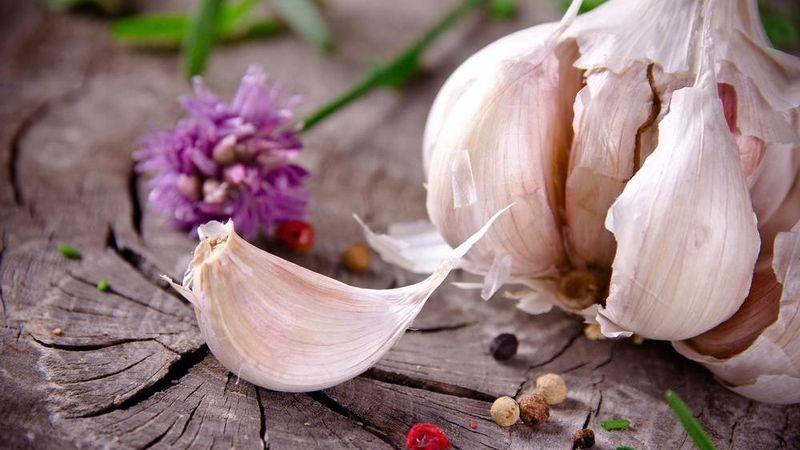
Growing garlic from bulbs
It takes about 2 years to grow garlic from bulbs. To preserve the seed, the seeds should be wrapped in newspaper and put in a dry, dark place with a temperature of + 18-20 degrees. Transfer to cold (0 + 4 degrees) 1.5 months before planting.
Then dry the cloves, disinfect them in potassium permanganate, and then proceed to planting (depth 3-4 cm, distance when planting garlic 3 cm, row 15 cm). Then compact the earth and cover with mulch. Collecting bulbs begins in early August.
Dry the harvested crop in the shade in a ventilated room, in no case leave it in the sun.
How to choose a planting time for garlic
The right timing for planting is a guarantee of a bountiful harvest.
Planting times of garlic in different areas
So, winter garlic is planted before the cold comes. In the regions of the middle lane, the planting time of the culture falls on October. In more southern areas with mild climates, this vegetable is planted at the end of November.
Spring (summer) garlic is planted when the snow begins to melt. In areas of the middle lane, it is better to plant in April, and in a region with a cold climate - at the end of May.
To what date garlic is planted, you can find out by the lunar calendar.
Lunar calendar for planting garlic in 2018
In the northern regions, the winter species is planted in September. The lunar calendar indicates what date to plant garlic: 1, 5, 6, 18, 19, 27, 28, 29 September.Do not plant on the full moon and the new moon, which lasts three days. In September 2018, it will be: new moon - September 8, 9, 10 full moon - September 25.
In October, according to the lunar calendar, the following dates are recommended for landing: 11, 12, 13, 14, 15, 16, 25, 26, 29, 30 October. There is no need to work with plants: on the new moon - October 8, 9, 10 (the new moons in September and October coincided); on the full moon - October 24.
When to plant arrowhead garlic seeds:
- March - 14.15, 18, 23, 27, 29, 30;
- April - 8, 14, 18, 26, 29;
- May - 1, 2, 4, 10, 11, 23, 27.
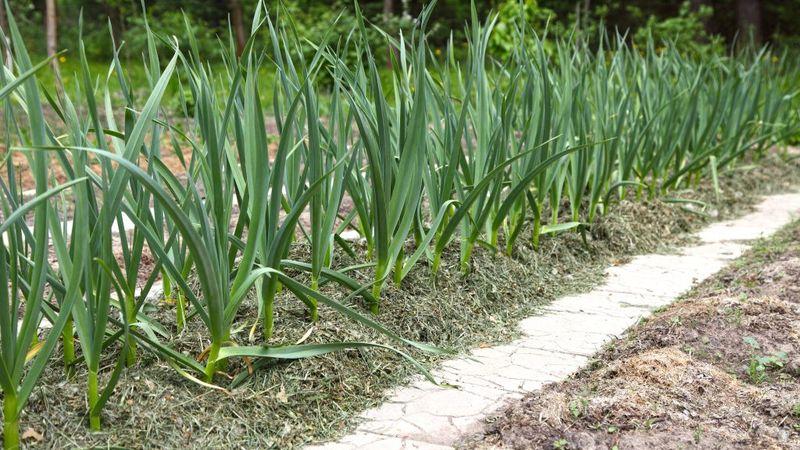
What can be planted next to garlic
Garlic plays the role of a fungicide, as it has a high concentration of biologically active substances. It copes with any fungal infections and inhibits the growth of pathogenic bacteria, therefore it has a beneficial effect on its neighbors.
Wondering what to plant next to garlic or what to plant next to garlic? Various combinations are suitable. For example, next to garlic, potatoes are protected from late blight, strawberries are protected from harmful insects, lettuce and carrots are protected from leaf flies and carrot flies.
Garlic is also an excellent protector of flowers and berries. The neighborhood with currants, raspberries, gladioli, roses and tulips is especially favorable.
Conclusion
So, you've learned how to plant garlic correctly, when to plant garlic and how to grow it. When choosing a variety of garlic, consider what time of year you want to harvest.
For autumn planting, winter garlic is chosen, for spring planting - spring garlic, they have their own characteristics and characteristics.
Carefully and responsibly approach the preparation and process of planting a plant, and then the harvest will surely please you.